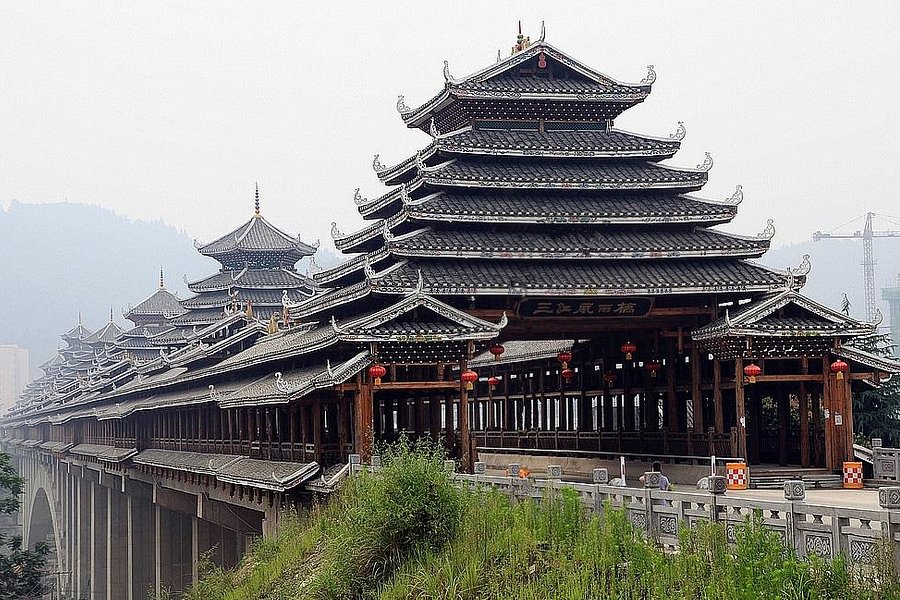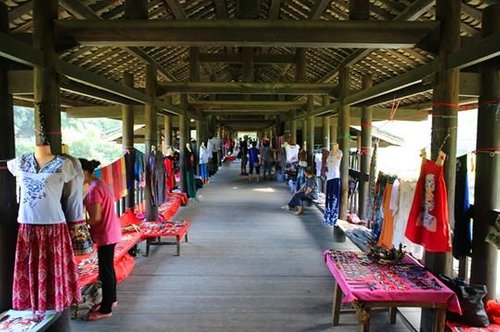Chengyang Wind and Rain Bridge, Guangxi, China
4.5 (91 reviews) Spent Ranking #1 in Sanjiang Architectural Buildings • Bridges

Stay a night after Longji
I wouldn't visit from Guilin, but from the rice terraces it was worthwhile. I stayed two nights, but one night would've been enough if you leave the next day later in the afternoon. The bridge is best enjoyed early morning or at night without the chaos of salesladies and tourists. The villages were pleaant to wander around, though I felt really intrusive as a tourist. The Dong minority performances (3x daily, they get you to take a sip of baijiu at the beginning which you tip them for, most gave 10rmb) was interesting. Getting there: From Pingan (Dazhai would work too) I took a bus to Longsheng (10rmb) then another bus to Sanjiang (19rmb). At Sanjiang east bus station (he dong) there are minivan drivers outside who repeat "chengyang qiao" and will likely approach you if you look like a traveler. One charged 60rmb for 2 people but wouldn't go lower than 50rmb for 1. I ended up going with a driver for 80rmb (ticket "included") who transferred me to another driver at the very end who got me in without buying an official ticket, but who provided me with an old ticket (I was adament ahout wanting a ticket just in case, but no one ever asked for it). That driver helped me get a room for 50 rmb at Yang Yang Lv Guan (call Mr Yang2 136-7780-4018, no English), to the right side of Long Feng Hotel (80rmb). I bargained to a better room for the same price (instead of 60rmb) by staying two nights. Pleasant twin room with a nice view of village roofs and mountains, so-so bathroom, but I did see a roach taking shelter on the wall one night when it rained buckets outside. Going back to Sanjiang, I caught one of the local minivans for 10rmb though it should've been 6rmb. Buses from Sanjiang go to Nanning too, but i caught one to Guilin for 50rmb.



Address
Guyi Town, Sanjiang 545500 China
Current local date and time now
Wednesday, May 15, 2024, 7:17
User Ratings
4.5 based on (91 reviews)
Reviews
-
5Kwok-leung Paul L 5:00 PM May 27, 2015
Covered Bridges, Drum Towers & More
Chengyang Bridge & Villages The famous covered Dong bridge of ChengYang is now frequented by tourists and filled up with souvenir stalls during business hours. But if you stay you may still enjoy the bridge from late evening till early morning. Villagers are still very friendly despite the commercial development. I was glad to be found by an old lady selling touristy souvenir. She show me some nice old textile not on display and invited me to see her collection at home. It was a small discovery to find that there were still some beautiful works of art in such a touristy village. I got a very nice piece of embroidered baby carrier. As a tourist theme park Chengyang is not big. The entrance ticket is at RMB60 in low season of early 2015. A professional song and dance troupe will perform touristy programs a few times everyday. No extra charge. There is no karaOK and bars because ChengYang is not the kind of the most popular destinations. During my visit in spring there was also good looking scenic landscaping works like bonsai gardening: blocking the river to create water reflection, and growing the oil seed flowers to create springtime beauty. ChengYang as many other villages newly transformed into tourist destinations there are quite some strange looking buildings. It is because of urbanization has brought in modern concrete houses but the urban look of concrete houses is not up to the imagination and expectation of many tourists. The solution was to wrap concrete house with wood strips or to paint them with wood patterns. Sometimes a tile roof on top was also added. The aim was to coverup the concrete and bricks but most of the time the packaged houses were most eye-catching. Sanjiang County This formerly inaccessible ethnic area is now completely open to the outside world. So amazing it is possible to get on a new train running at 250 km/hr. It may also speed up to over 300 km/hr! There will be more high-speed rails and highways open soon. Sanjiang has been a successful pioneer implementing the national policy to alleviate poverty by developing ethnic culture for mass tourism. But you will not find very huge projects turning ethnic villages into commercial theme parks. Many tourism development are in the county town. Convenient for tourists and less invasive to heritage villages. Some ethnic festivals have been made very famous by official media and have become very large-scale touristy events in Sanjiang. Prepare a flexible logistics. During the festival period traffic in the vicinity will certainly come to a standstill. The sights and sounds of the traditional ethnic music in festivals are extremely impressive. For tourists there are always some kind of performance choreographed based on original culture to certain extend. It may be similar to the shows commonly found in ethnic theme parks. If not interested. During the time of performance most tourists will be attracted. Then it would be a great opportunity to enjoy the festive scene and take some photos without any urban visitor hanging around in your frame. In these big festivals police are quite prominent. They are after some people you do not want to meet. Unfortunately I met them in my recent visit. Two pick-pockets made a deep cut into my photo vest. The cut had also reached to my travel pouch for keeping cash. Luckily I found the pick-pockets getting too close in time and did not lose my money pouch, a photo lens and the little note book. Watch out in crowded places. Besides, relax it is still very very safe to go around. Sanjiang is on the ancient navigation route system Duliu River connecting the ethnic backwaters towards Guizhou and the more developed Han regions down river towards cities such as Liuzhou and Canton. From long time ago Sanjiang was an area various ethnic groups meet and interact. Cultural fusion are most interesting and prominent. It is not difficult to see these fusion of culture and also the peoples involved: A Dong costume may look exactly the same as a Miao costume. Only the local can tell the minor difference; A Dong festival may be carried out in a Han Chinese style in the form of temple fair; A Dong opera troupe may perform Han Chinese shows as well, in Han Chinese dialect; Inside a Han Chinese style temple you may find ethnic deities mostly; Some Miao people speak mainly Dong language, build iconic bridges and drum towers of the Dong tribe. In addition they sing folk songs in Han Chinese dialect which was passed down from their Han ancestors. Cultural fusion has also gained new strength from the fast economic growth in recent years - many Dong women nowadays are also adorning in Miao style silver crowns as a new local fashion. Ancestral halls are usually common in Han Chinese region but not ethnic area. In a small town in Sanjiang I discovered by chance a very special ancestral hall belonging to a Dong ethnic family clan. Members of this Dong clan used to come together once every year to worship their Han Chinese ancestors. The annual worship includes representatives from clan members living in other county as Han Chinese and also representatives from clan members living in a Miao village up in the mountain as Miao minority. So, in this particular clan there is only one surname but members are belonging to three ethnic groups. The bad news for Sanjiang regions is the traditional textile and costume heritage had suffered a lot. Many ladies, especially the Miao women have already abandoned the traditional textile making heritage, however they are still very serious about keeping their ethnic styles, in a modern way - using lots of materials and parts from factories; the colors of traditional indigo blue have been replaced by a wide variety of bright colors; lots of modern shiny reflective materials are added onto the costume resulting in a stage look. Many ladies are also getting too busy to make their own costumes at home. This has contributed to the flourishing business of many small tailoring shops producing ethnic costumes.
-
4ohfernlish 5:00 PM Jun 20, 2014
Stay a night after Longji
I wouldn't visit from Guilin, but from the rice terraces it was worthwhile. I stayed two nights, but one night would've been enough if you leave the next day later in the afternoon. The bridge is best enjoyed early morning or at night without the chaos of salesladies and tourists. The villages were pleaant to wander around, though I felt really intrusive as a tourist. The Dong minority performances (3x daily, they get you to take a sip of baijiu at the beginning which you tip them for, most gave 10rmb) was interesting. Getting there: From Pingan (Dazhai would work too) I took a bus to Longsheng (10rmb) then another bus to Sanjiang (19rmb). At Sanjiang east bus station (he dong) there are minivan drivers outside who repeat "chengyang qiao" and will likely approach you if you look like a traveler. One charged 60rmb for 2 people but wouldn't go lower than 50rmb for 1. I ended up going with a driver for 80rmb (ticket "included") who transferred me to another driver at the very end who got me in without buying an official ticket, but who provided me with an old ticket (I was adament ahout wanting a ticket just in case, but no one ever asked for it). That driver helped me get a room for 50 rmb at Yang Yang Lv Guan (call Mr Yang2 136-7780-4018, no English), to the right side of Long Feng Hotel (80rmb). I bargained to a better room for the same price (instead of 60rmb) by staying two nights. Pleasant twin room with a nice view of village roofs and mountains, so-so bathroom, but I did see a roach taking shelter on the wall one night when it rained buckets outside. Going back to Sanjiang, I caught one of the local minivans for 10rmb though it should've been 6rmb. Buses from Sanjiang go to Nanning too, but i caught one to Guilin for 50rmb.